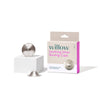There are all kinds of emotions that come with returning back to work after giving birth. You may be gearing up to go back to a daily routine, or you may want to stay curled up with your little one for a little while longer. Whatever emotions you’re feeling are completely normal and valid.
Often the most daunting aspect of returning back to a normal daily routine is pumping at work. Working a pumping schedule into your already busy 9-5 is no easy task, but with our simple tips and tricks we know you’ll be on your way to success. And for all our hybrid or working from home mamas, we’ve got you covered too!
Keep reading to learn how to build your own pumping at work schedules, and advice for returning back to everyday life.
How Often Should You Pump at Work?
During your work day you should try to pump every 3-4 hours for about 15-20 minutes a time. Base your pumping frequency off of how often your baby feeds each day. Remember that milk is produced on a supply and demand basis. In order to maintain your milk supply, you’ll need to stick to a strict pumping schedule.




















